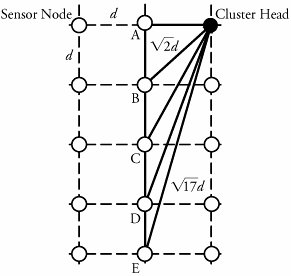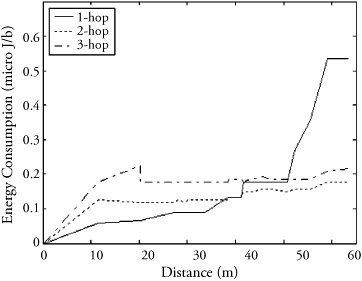Section 20.2. Communication Energy Model
20.2. Communication Energy ModelIEEE standardsas 802.11a, b, and g provide a wide range of data rates: 54, 48, 36, 24, 18, 12, 9, and 6 Mb/s. This range reflects the trade-off between the transmission range and data rate intrinsic in a wireless communication channel. An accurate energy model is crucial for the development of energy-efficient clustering and routing protocols. The energy consumption, E , for all components of the transceiver in watts is summarized as Equation 20.1 where is the distance-independent term that accounts for the overhead of the radio electronics and digital processing, and ·‰d n , is the distance-dependent term, in which · represents the amplifier inefficiency factor, ‰ is the free-space path loss, d is the distance, and n is the environmental factor. Based on an environmental condition, n can be a number between 2 and 4, and · specifies the inefficiency of the transmitter when generating maximum power ‰d n at the antenna. Clearly, the distance-dependent portion of total energy consumption depends on the real-world transceiver parameters, , · , and the path attenuation ‰d n . If the value of overshadows ·‰d n , the reduction in the transmission distance through the use of multihop communication is not effective. In theory, the maximum efficiency of a power amplifier is 48.4 percent. However, practical implementations show that the power-amplifier efficiency is less than 40 percent. Therefore, is calculated assuming that · = 1/0.4 = 2.5. Using Equation (20.1), we can express the energy consumption of a transmitter and a receiver, E T and E R , respectively, by Equation 20.2 and Equation 20.3 where T and R are the distance-dependent terms for the transmitter and the receiver, respectively. Although maximum output power and total power consumption are provided in the manufacturer's data sheet, can be calculated the following formula: Equation 20.4
Table 20.2 shows the expected data rate for the 802.11g wireless technology. Although exploiting the multirate capabilities of wireless standards has never been proposed for sensor networks, this technique can decrease the transmission energy for smaller distances by switching to higher data rates and keeping the transceiver on for a shorter period of time. In this case, the energy in terms of Joule/bit reduces discretely as transmission distance shrinks: Equation 20.5 Table 20.2. Expected data rate of IEEE 802.11g technology
where R is the rate in bits/sec. Figure 20.4 shows energy consumption using 802.11g technology at the constant rate of 1 Mb/s and the same technology with the multirate extension. Owing to large values of compared to the maximum output power, singlerate communication energy consumption remains constant as the transmission distance increases, whereas the communication energy consumption for multirate transmission decreases for shorter transmission ranges. However, this scenario does not follow the model of ‰d n . Meanwhile, the multirate communication necessitates the presence of a robust rate-selection protocol. Figure 20.4. Energy consumption versus transmission distance for single-rate and multirate communication using 802.11g technology Multi-Hop Communication EfficiencyConsidering the impact of real-world radio parameters and multirate communication, we should reevaluate the effectiveness of multihop communications. Since a multirate communication reduces energy consumption for shorter distances by switching to higher data rates, multihop communication can conserve energy. The traditional objective of multihop communication is to divide the transmission distance into a number of hops, m, and to relatively conserve energy, considering Equation (20.3), by means of Equation 20.6 However, if the division of transmission distance happens when the maximum range is less than 18.75 m for standard 802.11g, the data rate remains constant, and total energy consumption multiplies by the number of hops. Since sensor networks deal with two-or even three-dimensional spaces, multihop efficiency depends on the network scale and density.
Figure 20.6. Communication energy versus distance from cluster head for 802.11g technology |
EAN: 2147483647
Pages: 211


